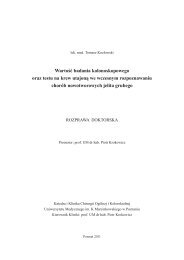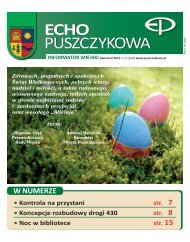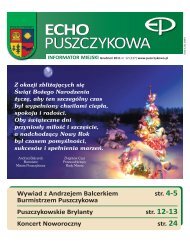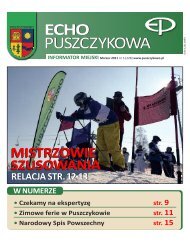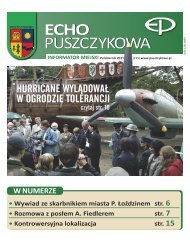MILITARY PHARMACY AND MEDICINE
MILITARY PHARMACY AND MEDICINE
MILITARY PHARMACY AND MEDICINE
Create successful ePaper yourself
Turn your PDF publications into a flip-book with our unique Google optimized e-Paper software.
© Military Pharmacy and Medicine EDITORIAL POLICY <strong>AND</strong> GENERAL INFORMATIONcorresponding author responsible for manuscript preparation,in the following format:Antoni Penc MD PhD, Department of Radiology, University Hospital,Dobra 22, 01-153 Warsaw, POL<strong>AND</strong>; phone (+48)227786734,fax: (+48) 227776671; e-mail: antoni.penc@wp.pl;••Summary - no more than 15 lines, single-space;••Key words (5 to 10) or short phrases should be written at thebottom of the page including summary. The use of the itemsincluded in Index Medicus (Medical Subject Headings) isrequired;••Source(s) of support in the form of grants (quote the numberof the grant) equipment, drugs etc;••Statement that neither this manuscript nor one with substantiallysimilar content or research under my (our) authorship has beenpublished or was sent for publication elsewhere.4) Structured Summary: (up to 250 words), consisting of the followingsections: Background and study aim, Material and methods,Results, Conclusions:e) Introduction (or Background): should contain scientificrationale and the aim of the study or (in case of a review)purpose of the article;f) Material and methods: brief description of the study; in the caseof review article - characteristics of the literature; for a case study- a brief description of the patient, the main parameters, etc.g) Results: concisely and reasonably summarize the findingsh) Conclusions: the principal conclusions (in Summary: 1-2)drawn by the authors of the presented results. For review papersthe above-mentioned structure is not required.9) TEXT. The text of the article should be divided to six paragraphslabeled: Introduction (or Background), Material and Methods,Results, Discussion, Conclusions, References. Prior references,if necessary, you can attach Acknowledgements, and at the endof work - Appendix. Each of these sections must be clearlyseparated with the bold title.Where appropriate, depending on the content of the article, youcan use a different layout, however, on condition that the structureof work is clear, transparent and consistent. The editorsreserve the right to request the author(s) to improve the structureof manuscript.10) Introduction (or Background) should give the scientific and/orclinical rationale for researching the given topic, the primaryissues and controversies, an explanation of the aim of the studyand the primary thesis.11) Material and Methods should contain essential informationregarding how the experiment or research was conducted,including the essential characteristics of the experimental andcontrol groups (age, gender), inclusion and exclusion criteria,and the randomization and masking (blinding) method used.The protocol of data acquisition, procedures, investigatedparameters, methods of measurements and apparatus shouldbe described in sufficient detail to allow other scientists toreproduce the results. In the case of published methods, thenames with appropriate references should be given. Referencesand a brief description should be provided for methods thathave been published but are not well known, whereas new orsubstantially modified methods should be described in detail.The rationale for using such new or unknown methods shouldbe discussed, along with a balanced evaluation of these methods,not omitting their limitations. Drugs and other chemicalsshould be precisely identified, including the generic name,dosage, and route of administration.http://military.isl-journals.com/The statistical methods should be described in detail to enableverification of the reported results.Information regarding the patients’ informed consent should beincluded in the text of the article (see above: Patient confi dentiality).Study subjects should be identified only by arbitrarily assignedinitials or numbers. Any information contained in photographs,images, or other illustrations that could serve to reveal theperson’s identity should be thoroughly camouflaged or concealed.The faces of persons appearing in photographs should be maskedor covered with a black band, unless for compelling reasons thisis impossible.12) Results concisely and reasonably summarize the findings inthe form of text, tables and figures arranged in a logical andinternally self-consistent manner. The number of tables andfigures should be limited to those absolutely needed to confirmor refute the thesis. Data given in graphs and tables should not beautomatically repeated in the text. The number of observationsshould be clearly indicated, as well as exclusions or losses toobservation. Any complications that may occur in treatmentor examination should be reported.13) Discussion should deal only with new and/or important aspectsof the results obtained, without repeating in detail data or othermaterial previously presented in Background or Results. TheDiscussion should focus on the theoretical implications and/orpractical consequences of the findings, including suggestionsfor further research. The Discussion should compare the resultsof the present study to those obtained by other investigatorsmentioned in the text.14) Conclusions must be linked with the goals of the study. Newhypotheses with recommendations for further research shouldbe advanced only when fully warranted and explicitly justified.Include recommendations when appropriate. Unqualifiedstatements and conclusions not supported by the data obtainedshould be avoided.15) Acknowledgements list all those who have contributed to theresearch but do not meet the criteria for authorship, such asassistants, technicians, or department heads who provided onlygeneral support. Financial and other material support shouldbe disclosed and acknowledged. References, chosen for theirimportance and accessibility, are numbered consecutively inthe order of their occurrence in the text.References first cited in tables or figure legends must be numberedin such a way as to maintain numerical sequence with the referencescited in the text. The style of references is that of IndexMedicus. When an article has six or fewer authors, all shouldbe listed; when there are seven or more, only the first three arelisted, then “et al.”16) Original papers and review papers may not exceed the standardtypewritten pages 10-20, and case studies – 4 pages, includingreferences, summary, tables and figures.Editors may agree to exceed the number of pages in case of: summariesof habilitation dissertation and the habilitation dissertationon degree of doctor of pharmaceutical and medical sciences.17) One page of manuscript should contain 30 lines, with about 60characters each (approx. 1800 characters per page). The textmust be written in Times New Roman 12-point, double-spaced(except references, tables, captions, etc.), with the left margin,2.5 cm wide, but without the right margin, or the comment. Donot center the title and heading, do not use tabs and blank linesbetween paragraphs or calculations. Use only bold and italic.135



